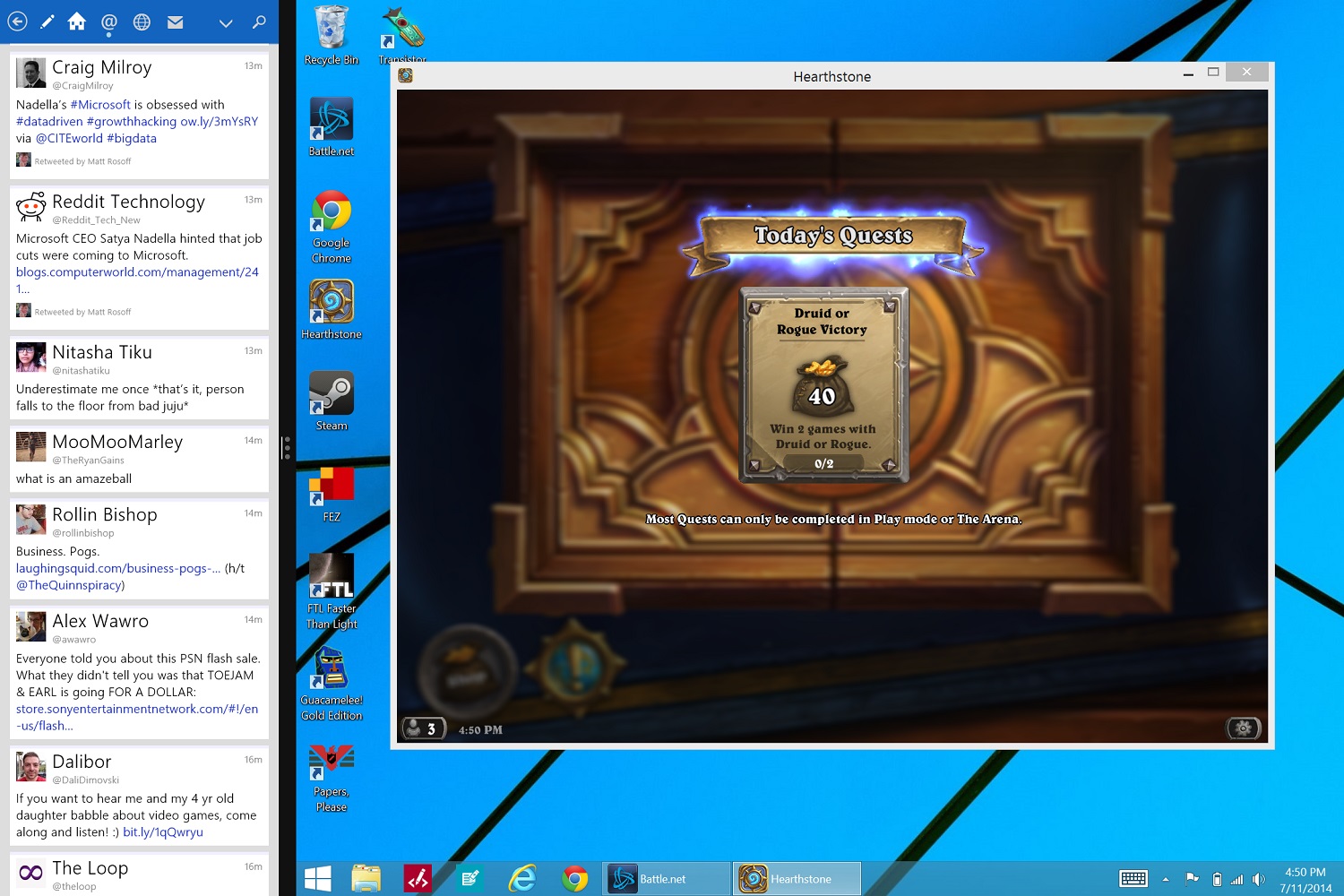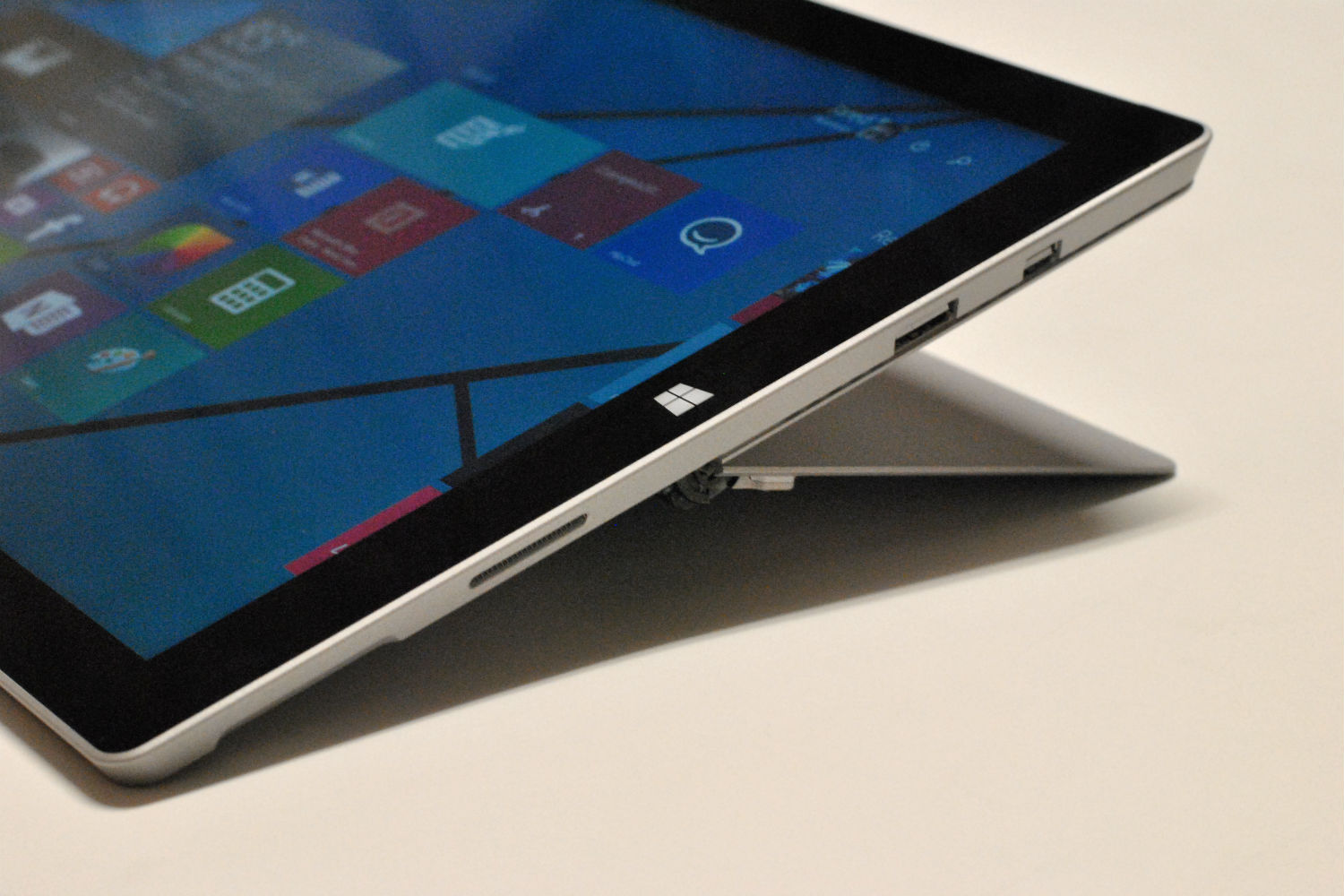As soon as Microsoft announced the Surface Pro 3, I kicked myself for being impatient.
Last fall, I bought a Surface Pro 2. The screen was smaller than I’d like, and the tiny, felt-covered trackpad was a detriment to traditional laptop use, but I wanted a light and powerful touchscreen device, and was tired of waiting for the perfect laptop-tablet hybrid.
The Surface Pro 3 tries to fix everything wrong with its predecessor, making fewer overall trade-offs as both a laptop and a tablet.
The screen is larger, and not as cramped for vertical space. The trackpad is roomier and covered in smooth glass. The kickstand adjusts to practically any angle. Yet the tablet is 0.2 inches thinner and a quarter-pound lighter than the Pro 2 — or 0.1 pounds lighter with the Type Cover keyboard attached — without any drop in battery life. It also has a heftier stylus and a dual-magnet keyboard that snaps to the tablet’s bezel for a raised typing surface. (Here’s a spec comparison with the MacBook Air.)
So while it pained me to do so, I dumped my Surface Pro 2 on eBay and bought a 256 GB Surface Pro 3 with an Intel Core i5 processor ($1,429 with the Type Cover keyboard) to replace it. I’ve now been using it for a month — some of that time with a Microsoft review unit before the release date — and it could be my ideal computer, if only the software didn’t have so many little annoyances.
The Surface Pro 3 appeals to me for several reasons. I already use Windows for work, mostly on the desktop in my home office, and I use OneDrive to sync my notes and documents between devices. I also play a decent amount of PC games for leisure, and I’m not allergic to using Windows Store apps for some tasks. I like the idea of a hybrid device for when I’m away from the desktop, since I don’t always a want a full-blown laptop if I’m just playing games or reading. (The stylus is nice to have, but I haven’t found much use for it as someone who doesn’t draw or write things by hand.)
In fact, there’s one scenario that sums up my Surface experience perfectly, pictured below:

Most of the screen is running the classic Windows desktop (and the absurdly addictive card game Hearthstone). I also have Tweetium snapped to the side, which is great for killing time between rounds. If I’m on the couch or in bed, I prop up the tablet with a kickstand, fold the Type Cover keyboard underneath and control everything with my fingers. But if I want to do some writing, I can pull out the keyboard and open WritePlus in the main window. Windows automatically saves the app’s .TXT files to OneDrive, so they’re waiting for me when I get back to my desktop.
Being able to do all this on a single device involves some compromises. Juggling the desktop and snapping Windows Store apps is sort of complex, and using touch with desktop apps isn’t always ideal. For writing, the Type Cover keyboard doesn’t have the same spacing and travel as a laptop keyboard, and the trackpad — while much improved over the previous Surface — still has less depth than those of dedicated laptops.
But the Surface Pro 3 also eliminates some complexity by not making me juggle multiple devices. If I’m taking a device up to my bedroom to play Hearthstone, I don’t have to think about whether I’m also going to do some writing or e-mailing before bed.
Granted, I could just use an iPad with a third-party keyboard, but this introduces its own trade-offs. The keyboard would not be full-size like the one on the Surface Type Cover, and all the fully adjustable keyboard cases I’ve seen add a lot of bulk, unlike the Surface tablet’s built-in kickstand. Likewise, I could just use a dedicated laptop, but that’s not as comfy when I’m just trying to relax with some games or watch the Yankees on MLB.tv. I could bring both a laptop and a tablet upstairs with me, but it’s a pain to switch machines for each task.
The Surface Pro 3 becomes the catch-all, and even if it’s not perfect as a laptop or tablet, the improvements in this version make the trade-offs more tolerable. The 12-inch screen with 3:2 aspect ratio runs about as wide as an 11-inch MacBook Air and about as tall as a 13-inch Air, so it actually feels like you’re working on a proper laptop. Being able to fully adjust the kickstand also helps in a lot of situations. For instance, I often use the Pro 3 while reclining knees-up on the couch, and now I can bend the kickstand all the way around so it’s tilting slightly outward from my legs.

As for in-lap use, someone with shorter legs might have trouble balancing the kickstand, but it’s never been an issue for me, even with the Pro 2. And while a kickstand isn’t as comfortable on the knees as the flat surface of a laptop, it brings to mind another trade-off: With the Surface, you don’t have any heat dissipating into your lap, because it all comes out the top of the tablet.
The only area where the Surface Pro 3 is a clear step down from its predecessor is gaming. That’s because Microsoft removed a “high performance” power option that unshackles the processor at the expense of battery life. Without this option — apparently removed to make room for Connected Standby — I don’t get the same uninterrupted smoothness in games like Fallout: New Vegas. The 3:2 aspect ratio also seems to create problems for some games. (At least there’s Steam in-home streaming from my desktop, which performed flawlessly and had no formatting issues.)
Overall though, the Surface Pro 3 is a fine piece of hardware. At this point, it’s only the software — and the wide variety of bugs and annoyances within it — that holds Microsoft’s hybrid back.
After two years, Microsoft still hasn’t figured out how to ship a device that isn’t riddled with problems, from obnoxious glitches to system-crippling bugs. At launch, the Surface Pro 3 needed a day-one patch to keep it from not turning on properly. But this patch in turn introduced Wi-Fi problems that persist on some machines, despite a recent firmware update.
Those are only the headline-grabbing bugs, but there are more. Sometimes the Type Cover stops working properly and I have to re-connect it. One time the system stopped fully responding to touch, and I had to restart it. Even an old problem I had on the Pro 2, where programs stopped responding to key presses until I hit “Alt,” reemerged on the Pro 3. I’ve noticed little design flaws as well, like the way Tweetium opens links in a second tab in Internet Explorer, leaving an open blank tab right next to it. There’s also the fact that some desktop programs, such as Google Chrome, still aren’t optimized for the Pro 3’s high pixel density display.
While you may not notice these things at first, over time, they build into a level of frustration unbecoming of a high-end device. And after using a Surface Pro 2 for six months, I’m not totally confident that Microsoft can get its tablet running smoothly through future updates.
Sad as that is, I choose to stick with the Surface Pro 3 because it’s the only two-in-one device that doesn’t feel sorely lacking on the hardware side. The bugs and glitches are a side effect that I can live with.
I do understand why Surface Pro 3 reviews have been mixed so far. If you perform two clinical evaluations of the Pro 3 — first as a laptop, then as a tablet — you’ll find some deficiencies on both ends and conclude that getting two separate devices is better. But there’s also a middle ground where having one device makes life easier, and the Surface Pro 3, in spite of its software woes, covers that ground better than anything else I’ve tried.
More Must-Reads from TIME
- Donald Trump Is TIME's 2024 Person of the Year
- Why We Chose Trump as Person of the Year
- Is Intermittent Fasting Good or Bad for You?
- The 100 Must-Read Books of 2024
- The 20 Best Christmas TV Episodes
- Column: If Optimism Feels Ridiculous Now, Try Hope
- The Future of Climate Action Is Trade Policy
- Merle Bombardieri Is Helping People Make the Baby Decision
Contact us at letters@time.com